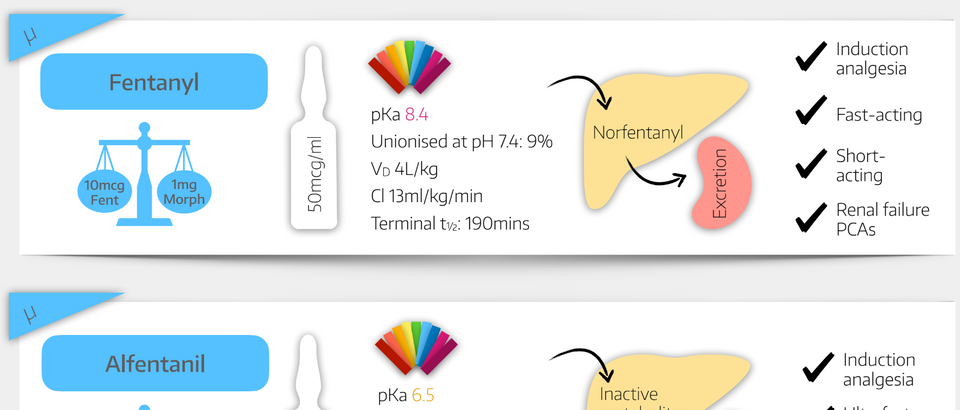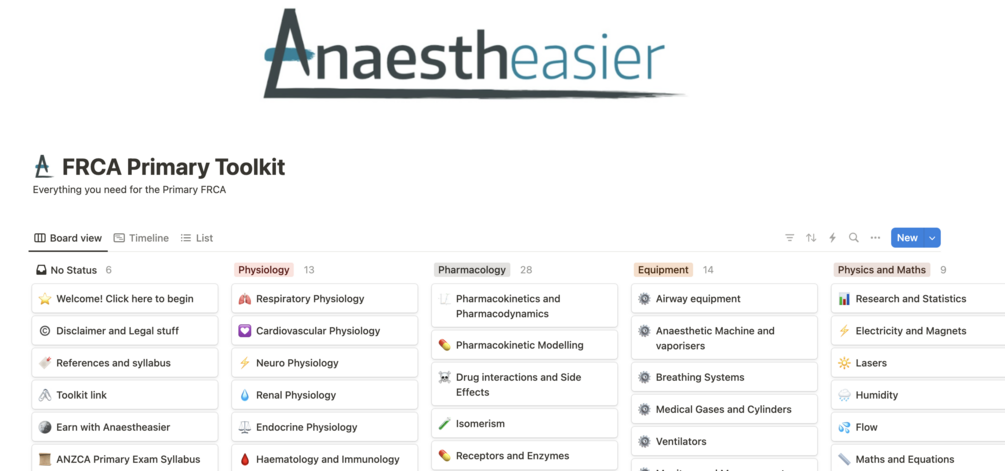Opioids

What is an opioid?
- A drug that acts on opioid receptors
- Opiates are a subset of opioids, which occur naturally, such as morphine
- They are commonly used to treat acute pain, and also as co-induction agents for general anaesthesia
- They are also used in regional anaesthesia techniques such as epidural and spinal blocks
- Side effects include nausea and vomiting, respiratory depression, pruritus, constipation and confusion
Objectives
- Recall the pertinent chemical, pharmacokinetic and pharmacological properties of Fentanyl, Alfentanil, Remifentanil, Morphine and Diamorphine
- Compare and contrast the properties of these drugs and their clinical uses in anaesthetic practice
- Use this knowledge and understanding to select an appropriate opioid for use at induction, for regional anaesthesia, for Awake Fibreoptic Intubation and for intra/post-operative analgesia in various clinical scenarios
Why do we use opioids?
Indications for opioids include
- Analgesia
- Anxiolysis
- Cough suppression
- Treatment of diarrhoea
What effects and side effects do opioids have in common?
Respiratory
- Respiratory depression
- Reduced sensitivity to hypoxia and hypercapnoea
- Suppression of laryngeal reflexes
- Chest wall rigidity
Cardiovascular
- Bradycardia
- Hypotension
Neurological
- Analgesia
- Anxiolysis
- Drowsiness
- Miosis
GI/GU
- Emetogenic
- Constipation
- Sphincter of Oddi spasm
- Urinary retention
Side effects
- Histamine release
- Bronchospasm
- Urticaria and pruritus
- Hypotension
- Dependence
- Tolerance, dependence and addiction can develop with chronic use
Morphine
Fentanyl
Alfentanil
Remifentanil
Diamorphine
What you need to know
- Diamorphine = Heroin = Diacetylmorphine
- Diamorphine has no intrinsic activity at opioid receptors
- Once it is deacetylated, it can exert its effect in the form of morphine
- 1mg Diamorphine = 2mg Morphine
- Diamorphine is much more lipid-soluble than morphine, making it ideal for use in neuraxial anaesthesia (spinal / epidural) where barriers such as the dura need to be crossed in order for it to exert its effect
Example OSCE/SOE question:
Tell me about diamorphine
Class and uses
- Diacetylated morphine derivative prodrug
- Metabolised to 6-monoacetyl morphine and morphine
- Used for analgesia, premedication and anxiolysis
Presentation and dose
- Tablets 10mg
- White powder for injection
- 5, 10, 30, 100 or 500mg vials of diamorphine hydrochloride
- 0.1-0.4mg intrathecal dose
- up to 3mg epidural dose
- up to 10mg IV for severe dyspnoea in pulmonary oedema
- Can also be given intrathecally or via the epidural route
Mechanism of Action
- μ receptor full agonist
Effects and side effects
Respiratory
- Respiratory depression
- Respiratory rate particularly affected
- Reduced sensitivity to hypercapnoea and to a lesser extent to hypoxia
- Suppression of laryngeal reflexes
- Chest wall rigidity
- Possibly via interaction with dopamine and GABA in the substantia nigra
Cardiovascular
- Bradycardia
- Hypotension
Neurological
- Analgesia
- Better for visceral pain than sharp pain
- Anxiolysis
- Drowsiness and sedation
- Triggers the most euphoria of all the opioids hence its addictive nature
- Miosis
- Stimulates the Edinger–Westphal nucleus
GI/GU
- Emetogenic
- Constipation
- Sphincter of Oddi spasm
- Urinary retention
Endocrine
- Inhibits ACTH release
- Increases ADH release
Side effects
- Histamine release
- Bronchospasm
- Urticaria and pruritus
- Particularly after epidural and intrathecal injection
- Hypotension
- Dependence
- Tolerance, dependence and addiction can develop with chronic use
Pharmacokinetics
Absorption
- Highly lipid soluble so well absorbed from the GI tract but significant first pass metabolism
- pKa 7.6 so 37% unionised in the blood
- Bioavailability of 30%
- Significant first pass metabolism
- Peak effect after 10mins when given IV
- 30mins when given IM
Distribution
- Higher lipid solubility than morphine makes it faster acting and safer for intrathecal injection, with reduced risk of cranial spread and delayed respiratory depression
- 40% protein bound
Metabolism
- Ester hydrolysis in plasma, liver and brain to 6-monoacetylmorphine and morphine
- Half life of 5 minutes
Excretion
- Renal excretion of all metabolites, which accumulate in renal failure
Side effects
Tell me about naloxone
Opioid antagonist at three opioid receptors, used for reversal of opioid overdose or toxicity
- μ is main target
- κ
- δ
Effects
- Hypertension
- Pulmonary oedema
- Arrhythmias
Dose
- 1-4 μg/kg IV
- Short duration of action of 30 mins
Why is alfentanil faster onset than fentanyl?
A really useful reference

Download our free opioid summary pdf

Everything you need to pass the Primary FRCA
FRCA Primary Toolkit
If you are looking for a single, easy to use resource that will comfortably get you through the Primary FRCA exam, look no further.This is a learning tool like no other. We know that everyone learns differently, some are visual learners, some like to listen, others like to write. What if you could do all of that in one place? All the highest yield content of textbooks, with the whole syllabus visible in front of you All the necessary information to pass the Primary FRCA, laid out in Viva format Links to our podcast and MCQ quizzes OSCE scenario videos and guidance Links and embeded videos from our website and YouTube channels All of our beautful summary pdfs in one place Always in your pocket, on your phone, tablet or computer Contains all of our Primary FRCA Brainscape Flashcards Totally customisable in the free Notion App Add your own notes Embed your own videos, audio files and diagrams Rearrange and reorder to suit your learning style Effortless build revision timetables It isn’t finished! What do we mean by this?It will continue to update with more resources and videos as we produce them, and as new evidence and guidelines are produced, we will add those in too, so you never have to pay to update it, or buy a new book! When it comes to exam time, you don’t need to make a revision timetable, simply flip over to timeline view, and drag the boxes to when you want to study them. Not only does this save you a huge amount of time, but you’ll know for sure that you’ve got all the topics covered because there won’t be any boxes left to allocate! Purchasing our toolkit also entitles you to 6 months free Anaestheasier membership - email Anaestheasier@gmail.com for more info Try it for FREE here to see if you like it before you buyTestimonials: I used only Anaestheasier since end of Sept and so did a lad I work with and we both passed - he did the exam yesterday which were totally different set of topics also and still passed - so thanks lads! Wish I had bought this kit before, I’ve been making my own notes but with 3 months until the November exam this will save me a lot of time to allow me to do more MCQs... I keep going down rabbit holes which occasionally end with reading papers (which is obviously not sustainable), so its great to have this as a guide for the depth of knowledge I need. Thanks for the amazing resource! Hey I just bought the toolkit - thanks so much it’s exactly what I’ve been looking for!This is literally perfect for how my brain works - It’s super easy to use and I can see exactly how much work I still have to doThank you thank you thank you thank you!Thank you for creating such a great resource for trainees. I have just done the SOE/OSCE this week and the online tool and the podcasts proved invaluable to both parts of the exam.From a Consultant and Primary FRCA examiner: It’s really user friendly, has all the right kind of information and very useful for viva practice - I’ll definitely be using this to teach my juniors in theatre If you feel that the toolkit has let you down in your studies, then please don’t hesitate to get in touch at anaestheasier@gmail.com so we can discuss reimbursement and compensation options with you.

Purchase our premium study tools here, or subscribe and get them for free


